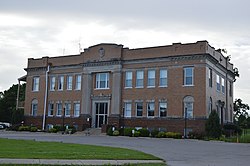Pulaski County, Illinois | |
|---|---|
 Pulaski County Courthouse in Mound City | |
 Location within the U.S. state of Illinois | |
 Illinois's location within the U.S. | |
| Coordinates: 37°14′N89°08′W / 37.23°N 89.13°W | |
| Country | |
| State | |
| Founded | 1843 |
| Named after | Casimir Pulaski |
| Seat | Mound City |
| Largest city | Mounds |
| Area | |
• Total | 203 sq mi (530 km2) |
| • Land | 199 sq mi (520 km2) |
| • Water | 4.0 sq mi (10 km2) 2.0% |
| Population (2020) | |
• Total | 5,193 |
• Estimate (2024) | 4,879 |
| • Density | 26.1/sq mi (10.1/km2) |
| Time zone | UTC−6 (Central) |
| • Summer (DST) | UTC−5 (CDT) |
| Congressional district | 12th |
| Website | www |
Pulaski County is a county located in the U.S. state of Illinois. According to the 2020 census, it had a population of 5,193. [2] Its county seat is Mound City. [3] Its largest city is Mounds. It is located along the Ohio River in the southwestern portion of the state, known locally as "Little Egypt".


